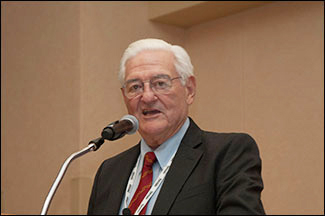Germplasm Evaluation Program
Expansive breed research project has rich history and exciting future.
by Kasey Brown, associate editor, Angus Journal®
LINCOLN, Neb. (June 18, 2014) — Most would not think of a meat animal research center spawning from a naval ammunitions depot, but it is indeed the history of one of the largest research projects evaluating breed characteristics — the Germplasm Evaluation (GPE) program. Research geneticists Larry Cundiff and Mark Thallman of the U.S. Meat Animal Research Center (USMARC), Clay Center, Neb., shared the history and current emphases of the center during the opening session of the 2014 Beef Improvement Federation (BIF) Annual Meeting & Research Symposium in Lincoln, Neb., June 18-21.

Larry Cundiff, research scientist for the U.S. Meat Animal Research Center (USMARC), Clay Center, Neb., highlighted the genetic trends for yearling weights for many of the breeds, noting their change over time.
The USMARC is celebrating 50 years and, of those, 45 of them have been involved with the GPE, said Cundiff. He credited Keith Gregory, the center’s first director, with having the vision for the impact livestock research would have and for setting up USMARC for success by seeding 30,000 acres to grass and establishing such large research herds. Additionally, he credited Bob Koch, Gordon Dickerson and Dale Van Vleck for the success of the germplasm project.
The Germplasm Evaluation Program, while intimidating in name and scope, provides practical information by determining breed differences and the optimization of characteristics in heterosis. The project used 37 breeds, including widely divergent biological types, in eight cycles.
The germplasm project is also the source of the across-breed expected progeny differences (AB-EPDs), which use adjustment factors to put noncomparable within-breed EPDs on a comparable basis. Angus was used as the base because it was the most popular breed, Cundiff noted.
Cundiff highlighted the genetic trends for yearling weights for many of the breeds, noting their change over time.
“British breeds have closed the gap on Continental breeds for yearling growth,” Cundiff said.

Among the many traits being studied, Mark Thallman said research is moving toward developing EPDs on novel traits, including disease resistance, meat quality, feed utilization and many others.
Timely release of progress reports and scientific publications has affected the choice of breeds used in beef production, Cundiff said. “Beef registrations tend to reflect germplasm project findings. Decisions can be made easier with the data, and this project will be even more critical in the future.”
Thallman explained the new structure of the project, which is being implemented to effectively use tax dollars. The philosophy is that it is more efficient to concentrate the collection of extensive and expensive phenotypes on populations that can be used for multiple objectives. USMARC has moved beyond cycles into continuous evaluation.
The project concentrates more on breeds that are used in the industry; this develops a population that is representative of the industry.
Among the many traits being studied, Thallman said research is moving toward developing EPDs on novel traits, including disease resistance, meat quality, feed utilization and many others.
Additionally, Thallman emphasized the multi-breed and novel trait nature of USMARC's genomics research. Sequencing influential bulls has begun. So far, 180 purebred bulls and 81 F1 bulls have been sequenced.
To learn more about the germplasm project, Thallman encouraged attendees to visit www.ars.usda.gov/Main/docs.htm?docid=6238.
The 2014 BIF Annual Meeting & Research Symposium was hosted by the University of Nebraska–Lincoln, the U.S. Meat Animal Research Center and the Nebraska Cattlemen June 18-21 in Lincoln, Neb. The Angus Journal and LiveAuctions.tv provide comprehensive online coverage of the event at www.BIFconference.com. Visit the Newsroom for summaries, proceedings, PowerPoints and audio of the sessions; the Awards page for announcements of award winners; and the Photos page for galleries of photos from the meeting and the tours.
Editor’s Note: This summary was written under contract or by staff of the Angus Journal®.Through an agreement with the Beef Improvement Federation, we are encouraging reprinting of the articles to those who will adhere to the reprint guidelines available on this site. Please review those guidelines or contact Shauna Rose Hermel, editor, at 816-383-5270. PowerPoints are posted with permission of the presenter and may not be reproduced in whole or in part without the express permission of the presenter.
The Angus Journal's coverage of the event is made possible through collaboration with BIF and sponsorship of LiveAuctions.tv. For questions about this site, or to notify us of broken links, click here.
Headquartered in Saint Joseph, Mo., Angus Productions Inc. (API) publishes the Angus Journal, the Angus Beef Bulletin, the Angus Beef Bulletin EXTRA, and the Angus Journal Daily, as well as providing online coverage of events and topics pertinent to cattlemen through the Angus Journal Virtual Library.



